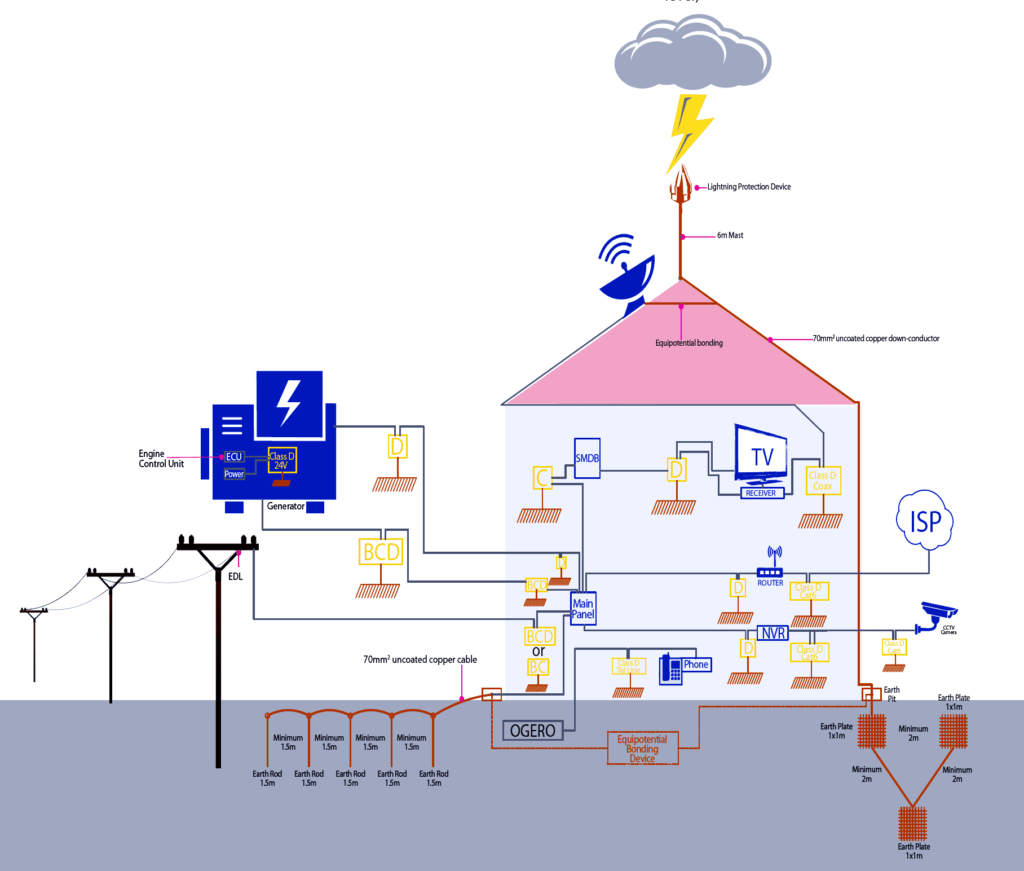All Lightning and Surge Protection
If your facility does not have a lightning protection system, a lightning strike can cause the lightning to divert from the ground. And, of course, a direct lightning strike into your home can cause serious damage.
Zod Security provides a full range of lightning protection equipment, with a vast list of lightning and surge protection references in the Middle East and North African Region (MENA):
Surge and lightning protection have a wide application that differs depending on the type of premises. It is usually installed on tall buildings, organizations, factories, mountain villas, high constructions such as churches domes and bells, GSM operators, wind turbines and more.
How to Protect Against Lightning
Surge protection is ensured by installing a surge protection device (SPD) on endangered lines. In the event of a surge voltage, the SPD diverts excess energy from the ground and limits peak voltage to a measurable level for the connected electrical equipment. Once peak voltage and current are reached, the device remains below critical level.
Lightning and surge protection devices can be integrated into discrete circuit protection systems to provide a higher level of functionality and protection. Industrial surge protectors exist only to keep the systems that protect them online and functional.
Due to the potential for lightning strikes, the integration of surge protection in weather-prone industrial installations is of crucial importance. Surge protectors can be integrated into the system at a price lower than the replacement cost of equipment damaged by surges. Surge arrester for socket strips can be used as well as devices for power supplies.
The terms Surge Protection Devices (SPD) and Transient Voltage Surge Suppressors (TVSS) are used to describe electrical devices installed in power distribution panels, process control systems, communication systems and other high-performance industrial systems to protect against electrical surge peaks, including those caused by lightning. Surge protection devices are used in power supply networks, telephone networks and automatic communication control buses. Enlarged versions of these devices are also installed in building entrances and control panels to protect household appliances from similar hazards.
Overvoltage protection (SPD) is part of an electrical installation or protection system. It is a protective device that limits temporary voltages, diverts or limits surge currents and is capable of repeating functions as prescribed.
Surge Protector, Spike Suppressors, Surge Suppressors and Surge Diverters (SPD) for TVs and devices are devices designed to protect electrical devices from voltage peaks in alternating current circuits. A voltage peak is a temporary event that can last from 1 to 30 microseconds and reach up to 1000 volts.
The 14.49% rate was given by the Underwriters Laboratory, which means that the AC surge suppressor has been tested for surge suppression. It also indicates that the device is compliant with the 1998 Thermal Fusing Standard, which means that it turns off the current when there is a sharp rise to prevent it from catching fire.
Surge protection devices can limit the effects of surge voltages on AC lines without expensive monitoring equipment. They are simple and can be purchased in department stores and used at home. Wireless protective devices using telemetry can also be used for this purpose.
Keeping surge protection wires as short as possible improves effectiveness and response time. Grounding wires are connected by an earth clamp to earth levels such as rods, copper or water pipes. If necessary, ground conductors should be connected to surge protection devices.
In some cases, the connection can be made with surge protectors, the so-called differential ground clamps. These devices keep the system isolated under normal conditions, but if there is a significant potential difference, they can be broken to balance the potential and make the system safer. Each system has unique characteristics, and SPD solutions can be tailored to provide the right lightning protection when the ground systems are in place.
Protection solutions derive energy surges from the earth in order to limit voltage peaks to a tolerable level for the connected devices. They can be installed parallel to the main system on the main switches, distribution boxes or printed circuit boards.
Why Install Lightning Protection
The lightning protection concept offers a cost-effective way to prevent fire, physical damage, system failures and other losses. To achieve this, a lightning protection system insulates endangered devices and areas from primary and secondary forms of lightning and associated influences. Selected lightning protection systems are designed and implemented in such a way that no form of lightning associated with destructive, disturbing, reliable or destructive phenomena can penetrate the system.
It should be noted that lightning has a probabilistic function, so that the number of lightning strikes ending in a region can vary from year to year or over a short period of a few years. While direct impacts can cause physical damage, the secondary effects of lightning can damage electrical and electronic systems in the protective area and cause fires.
As we have described in an earlier chapter on the physics of lightning, lightning surges are conducted into the ground by means of a lightning protection system consisting of an air deflector and an earth electrode. A lightning protection system should provide a safe way for the electricity to be diverted away from the ground. Surge protectors must comply with industry-specific exposure risk requirements.
Should you need more information, do not hesitate to contact us.




